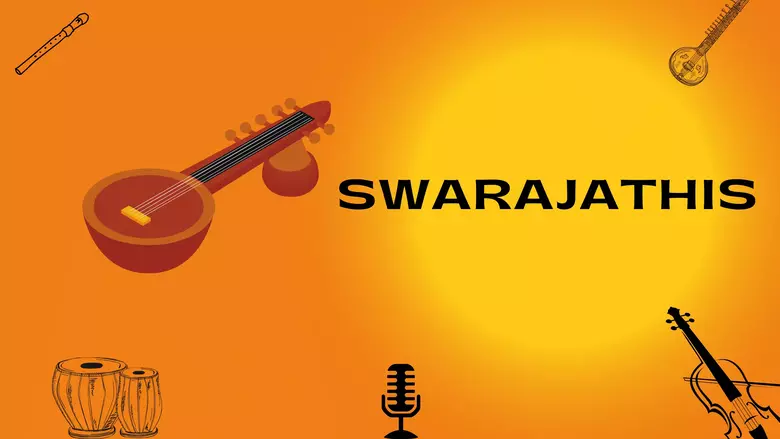Swarajathis are Carnatic music compositions, typically consisting of two or three stanzas. The word “swarajathi” comes from the Sanskrit words “swara” (meaning “tone” or “sound”) and “jathi” (indicating “classification”). Swarajathis are set to a specific raga (melodic scale) and performed at a medium to rapid speed. Because of the complex swara patterns and the quick pace, Swarajathis is one of the most challenging musical works to sing in the Carnatic tradition. Most of the time, advanced students of Carnatic music or professional musicians are the ones to sing them.
While listening to a Carnatic music concert, most audience members are likely aware of the swarajathis or solo pieces performed. But what is a swarajathi, and why is it an essential part of the Carnatic music repertoire? This blog post will explore the history and meaning behind these pieces and offer tips on approaching playing them.
What is Swarajathis?
Swarajthis is a very emotional rāga, evoking feelings of pathos and spiritual longing. It is often similar to Hindolam, another popular Carnatic rāga. Swarajathis are often used as a vehicle for improvisation, and many famous Carnatic musicians have composed swarajathis in various ragas. Some well-known examples of swarajathi compositions include “Sri Ganapathini” in Hamsadhwani raga, “Sri Rama Bhakti” in Mohanam raga, and “Bhagyada Lakshmi Baramma” in Shankarabharanam raga.
It is a composition in which the charanam (Pallavi/anupallavi/charanam) starts with combinations of the first swara in the aarohana of the raga. Then the corresponding Sahitya (words), maintaining the raga bhava in both, followed by the next swara in the aarohana.
This type of music is best illustrated by the swarajathis in the ragas, Bhairavi and Yadhukulakambodhi, of Shyama Sastri. Forming swarajathis with both aarohana and avarohana swarams would be too lengthy and unwieldy.
How do you Perform Swarajathis?
There is no specific way to perform a swarajathi, but some general guidelines can be followed:
- The composition requires improvisation.
- The singer should use their imagination and creativity to create the melody.
- The lyrics can be based on any topic but should be simple and easy to understand.
- The rhythm of the swarajathi should be easy to follow.
- The length of the composition can vary but should generally be around 3-5 minutes long.
- The swarajathi can be performed solo or with accompaniment.
- The composition can be sung in any language but should be easy to understand for the audience.
The Benefits of Learning and Playing Swarajathis
There are many benefits to learning and playing swarajathis.
- Swarajathis are a great way to improve your improvisational skills, as they require you to create a melody on the spot.
- Swarajathis are also an excellent way to learn a new raga, as you can hear how the composition sounds in that particular raga.
- Finally, swarajathis are enjoyable to sing and listen to, making them a great addition to any Carnatic music repertoire.
Famous Swarajathis Composers
Many famous composers have written swarajathis in various ragas. Examples include Muthuswami Dikshitar, Tyagaraja, Shyama Sastri, and Muttuswami Srinivasa Iyer. Each of these composers has composed swarajathis in multiple ragas, giving listeners a glimpse into how the composition can be performed.
Famous Swarajathi Compositions
Carnatic composers have written several popular swarajathi compositions. Some examples of famous swarajathi compositions include “Sri Ganapathini” in Hamsadhwani raga, “Sri Rama Bhakti” in Mohanam raga, and “Bhagyada Lakshmi Baramma” in Shankarabharanam raga. These compositions show the wide diversity of ragas utilized in swarajathi.
This song, “Sri Ganapathini,” is one of the most well-known songs in the Hamsadhwani raga. A famous Carnatic composer named Muthuswami Dikshitar wrote the piece.
Watch one of the most captivating swarajathis played in the breathtaking raga Bhairavi by one of the world’s most renowned musician,
Semmangudi Srinivasa Iyer
This is the first section, and it accounts for a significant portion of the krithi.
Please see parts two and three for details relating to the manodharma.
M.S. Subbhalakshmi
Swarajathi Practice Tips for Beginners
There are some practice tips that beginners can follow to learn how to play swarajathis:
- Listening to a range of recordings is the best way to learn about Swarajathis.
- Composing in numerous ragas will help you understand how the composition sounds when sung at different pitches.
- Improvisation of the composition is another way to improve Swarajathi. You’ll have a better idea of adjusting the composition after this.
[TABS_R id=13373]
Conclusion
Swarajathis are an essential part of the Carnatic music repertoire, and they can be an excellent way for musicians to showcase their skills. Consider taking Carnatic courses at Music Master if you wish to learn more about swarajathis and become a professional musician. With the proper training, you’ll be able to perform beautiful solos like a pro!
Related blog: Lesson 7: Sapth Swaras, Lesson 6: Saptha Thala Alankaras


































